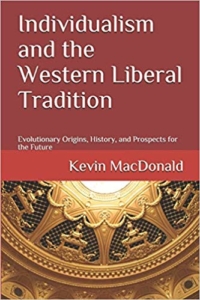Elena Kagan’s impending confirmation on the Supreme Court has produced several comments on the decline of WASP America. Writing in the Wall Street Journal (“That Bright, Dying Star, the American WASP”), Robert Frank’s article is an expression of Jewish triumphalism and contempt for WASPs. Discussing the New York banking elite, he points to the bad old days when “the strictly homogenous crowd of Protestant blue-bloods spent their mornings comparing golf scores and vacation homes.” Among several causes for the decline of the WASPs, Frank mentions the decline of family connections and the rise of a meritocracy.
This is a favorite aspect of contemporary Jewish self-conception — the idea that Jews replaced WASPs because they are smarter and work harder. But this leads to the ultimate irony: Kagan is remarkably unqualified to be a Supreme Court Justice in terms of the usual standards: judicial experience, academic publications, or even courtroom experience. Rather, all the evidence is that Kagan owes her impending confirmation to her Jewish ethnic connections (see also here).
So we are replacing one type of ethnic networking with another. At least the WASPs’ ethnic networking had a certain legitimacy given their percentage of the population and their role in founding the country and defining its culture for much of US history.
Frank also quotes a passage from E. Digby Baltzell’s The Protestant Establishment:
A crisis has developed in modern America largely because of the White-Anglo-Saxon Protestant establishment’s unwillingness, or inability, to share and improve its upper-class traditions by continuously absorbing talented and distinguished members of minority groups into its privileged ranks.
Perhaps. But that wouldn’t explain the eclipse of the WASPs, only that they resisted the inroads of others — futilely, as it turns out. Mr. Frank, of course, finds the passage useful because he sees himself as a member of a certain upwardly mobile minority group that he feels was not greeted warmly enough by the WASPs.
Baltzell’s comment is quite consistent with my view that that the WASPs did not voluntarily cede control but were pushed out by a rising Jewish group whose base of influence was the academic world, finance, the legal profession, personal wealth, and the media (where anti-WASP movies became a staple at least by the 1960s; see also here).
Frank says that as a result of its downfall, “WASP culture has been left to live out its days as a fashion statement, on the shelves of Ralph Lauren stores, or as a social badge at defiantly old-world clubs like the Knickerbocker Club in New York or the Bath and Tennis Club in Palm Beach.” A triumphalist statement if ever there was one. The battle is over and we won.
Frank quotes an Episcopalian bishop who acknowledges defeat, but isn’t much concerned: “tracking the ups and downs of socioreligious groups like WASPs [is] no longer relevant: ‘That kind of calibration of ‘what members of my team are on the front lines’ seems to me to be an antique kind of thing to do.’”
That’s the kind of broad-minded, liberal thinking that got the WASPs into trouble in the first place. There was always a tension between the WASPs as a clubby, snobbish elite cemented by family connections and their very liberal, broad minded world view stemming from their New England base. Writing in the LA Times, Gregory Rodriguez credits Kagan’s nomination to “The triumph of WASP culture.” Whereas Frank is filled with contempt for his vanquished ethnic rivals, Rodriguez seems quite thankful that the liberalism of the WASP elite was triumphant, presumably so that his people can now swarm over the border and aspire to power while WASP principles still count for something. He summarizes Eric Kaufmann’s view of WASP culture:
The Yankee sense of ethnic superiority often competed with their belief in universalist liberal ideology — equality, liberty and human rights. One way that worked itself out is that non-Yankees could aspire and acculturate to the Yankee norm and ideal — by gaining entrance to their schools primarily, but also by joining their churches, appreciating their art forms and imbibing their ideas, adopting their aesthetic.
Rodriguez concludes:
Students don’t just strive to attend Harvard and Yale for their educational excellence. There is also the matter of absorbing those universities’ sense of authority, legitimacy and historical legacy that leads back to their Yankee founders. If Kagan is confirmed, as seems likely, don’t cry for the WASPs. The educational pedigree of the Supreme Court will be a powerful example that their culture abides and still anoints power. The only thing that has changed is that today’s “WASP elites” are just as likely to be Jews and Catholics as they are to be Yankees.
I do cry a bit for the WASPs because I think they were more public spirited than our current elite and less likely to welcome a radical change in the ethnic balance of the country that they built. After all, the WASP elite did make common cause with the rest of White America in fashioning the 1924 immigration law (the “period of ethnic defense”). But they ultimately fell to the rise of a new Jewish elite that has shown itself as intent on establishing alliances with non-White ethnic groups and has taken an oppositional stance toward the traditional people and culture of America — including the WASPs. The “Jews as a hostile elite” theme of much of my writing.
And to claim that it really doesn’t matter what people’s ethnic or religious identity are as long as they graduate from an Ivy League university is completely nutty. Ethnicity matters a great deal, no matter what university one graduates from. The fact that Elena Kagan is the product of New York’s Jewish leftist sub-culture makes a huge difference in what we can expect from her — particularly given her views on the First Amendment and executive power that are in line with the mainstream Jewish community.
The Jewish leftist subculture is light years away from traditional WASP culture. Indeed, in her article on Thurgood Marshall, Kagan completely rejects the WASP cultural influence:
The Constitution today … contains a great deal to be proud of. But the credit does not belong to the Framers. It belongs to those who refused to acquiesce in outdated notions of ‘liberty,’ ‘justice,’ and ‘equality.’
The fact that Kagan’s Jewish leftist subculture has become ensconced at Harvard and other elite academic institutions speaks volumes on the massive changes that have taken place in the academy and WASP America generally. Rodriguez is deluded (in a self-interested way) to suppose that changing the ethnicity of Supreme Court justices won’t change anything as long as they graduated from Ivy League colleges.
The WASPs had their faults certainly. But their main one was their failure to block the emergence of a non-WASP elite — to go down with their principles. I rather doubt that this new elite will be as willing to see itself eclipsed as the old one was. It will hang on to power with no regard at all for principles. Indeed, a good example of corruption and lack of principle among the new elite are the many defenses we now see of Kagan emanating from elite opinion makers despite her being the poster girl for ethnic nepotism and lack of real accomplishment.








